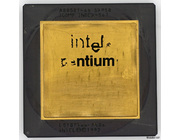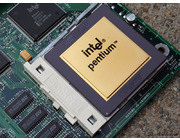The first Pentium processor is code-named P5 and was released in two versions; 60MHz and 66MHz. It contains 3.1 million transistors, uses 5V to operate and is made in a 0.8 µm process.
Major differences in the Pentium are:
Superscalar architecture
The Pentium has two pipelines (datapaths) that allow to complete two instructions per clock cycle. The main pipe can handle any instruction, while the other can handle most common simple instructions.
64-bit external databus
Doubles the amount of data being transferred to the memory and I/o compared to a 486.
Seperation of code and data cache
Decreases the fetch and operand read/write conflicts.
Faster floating point unit
The high-end choice in 1993. The fastest early Pentium which outperformed faster clocked 486's. Most early Pentium's one would see are from 1994, even though the Pentium was released in March 1993. Back in it's day it was too expensive for most people so not many Pentiums have been sold in 1993.
This particular model is from mid 1994 and has the FDIV bug. > Read more
The classic Pentium at 60MHz. This is the first Pentium-class CPU along with its 66MHz counterpart.
Compared to a 486 the Pentium had several improvements including a superscalar architecture, 64-bit external data bus and a faster Floating Point Unit (FPU). The superscalar architecture allows the Pentium to complete more than one instruction per clock cycle and the 64-bit data bus allowed faster communication with the internal RAM. Due to the bigger bus SIMM's always have to be installed in pairs. One SIMM is 32-bit.
The FPU used pipelining (see this 486 that explains pipelining) to make it faster. The first Pentium CPU's (60~100MHz) had a problem in the FPU that resulted incorrect but predictable results. My Pentium 60 (as seen on the photo) also has the bug. The bug was detected in 1994 and eliminated in the end of 1994 meaning that only the oldest Pentium CPU's have the bug. Intel started a program to replace the bugged CPU's.
When running the Pentium 60 I noticed that both the chipset and the Pentium processor ran quite hot. The Pentium CPU needs 5V for operation which is a lot more compared to the newer Pentiums (P54; from 75MHz). Besides that everything ran normal. > Read more



